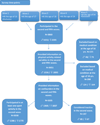Diversity of leisure-time sport activities in adolescence as a predictor of leisure-time physical activity in adulthood
- PMID: 28106293
- PMCID: PMC5806530
- DOI: 10.1111/sms.12837
Diversity of leisure-time sport activities in adolescence as a predictor of leisure-time physical activity in adulthood
Abstract
Because sustained physical activity is important for a healthy life, this paper examined whether a greater diversity of sport activities during adolescence predicts higher levels of leisure-time physical activity (LTPA) in adulthood. From sport activity participation reported by 17-year-old twins, we formed five groups: 1, 2, 3, 4, and 5+ different sport activities. At follow-up in their mid-thirties, twins were divided into four activity classes based on LTPA, including active commuting. Multinomial regression analyses, adjusted for several confounders, were conducted separately for male (N=1288) and female (N=1770) participants. Further, conditional logistic regression analysis included 23 twin pairs discordant for both diversity of sport activities in adolescence and LTPA in adulthood. The diversity of leisure-time sport activities in adolescence had a significant positive association with adulthood LTPA among females. Membership in the most active adult quartile, compared to the least active quartile, was predicted by participation in 2, 3, 4, and 5+ sport activities in adolescence with odds ratios: 1.52 (P=.11), 1.86 (P=.02), 1.29 (P=.39), and 3.12 (P=5.4e-05), respectively. Within-pair analyses, limited by the small sample of twins discordant for both adolescent activities and adult outcomes, did not replicate the association. A greater diversity of leisure-time sport activities in adolescence predicts higher levels of LTPA in adulthood in females, but the causal nature of this association remains unresolved.
Keywords: behavioral epidemiology; cohort study; exercise; longitudinal; twin study; youth.
© 2017 John Wiley & Sons A/S. Published by John Wiley & Sons Ltd.
Figures


References
-
- Aaltonen S, Ortega-Alonso A, Kujala UM, Kaprio J. Genetic and environmental influences on longitudinal changes in leisure-time physical activity from adolescence to young adulthood. Twin research and human genetic: the official journal of the International Society for Twin Studies. 2013;16(2):535–543. - PubMed
-
- Aarnio M, Winter T, Peltonen J, Kujala UM, Kaprio J. Stability of leisure-time physical activity during adolescence--a longitudinal study among 16-, 17- and 18-year-old Finnish youth. Scandinavian Journal of Medicine & Science in Sports. 2002;12(3):179–185. - PubMed
-
- Aaron DJ, Storti KL, Robertson RJ, Kriska AM, LaPorte RE. Longitudinal study of the number and choice of leisure time physical activities from mid to late adolescence: implications for school curricula and community recreation programs. Archives of Pediatrics & Adolescent Medicine. 2002;156(11):1075–1080. - PubMed
-
- Ainsworth BE, Haskell WL, Herrmann SD, Meckes N, Bassett DR, Jr, Tudor-Locke C, Greer JL, Vezina J, Whitt-Glover MC, Leon AS. 2011 Compendium of Physical Activities: a second update of codes and MET values. Medicine and science in sports and exercise. 2011;43(8):1575–1581. - PubMed
Publication types
MeSH terms
Grants and funding
LinkOut - more resources
Full Text Sources
Other Literature Sources
Medical

